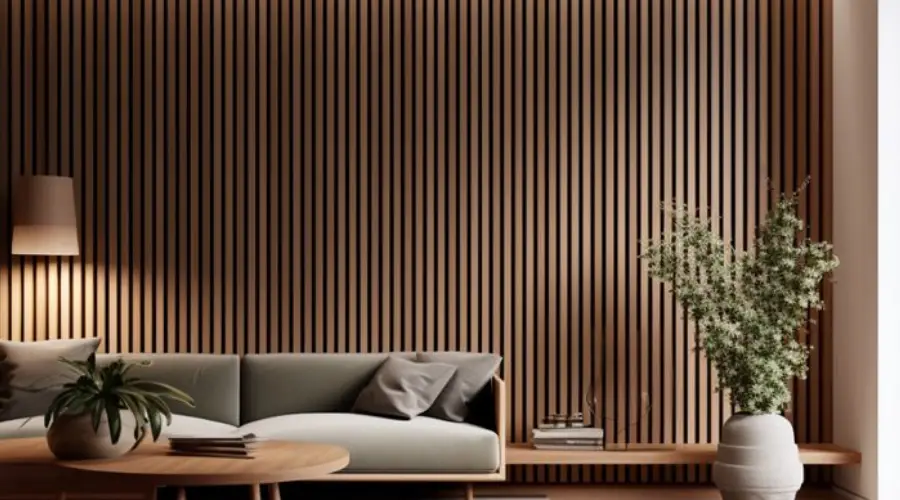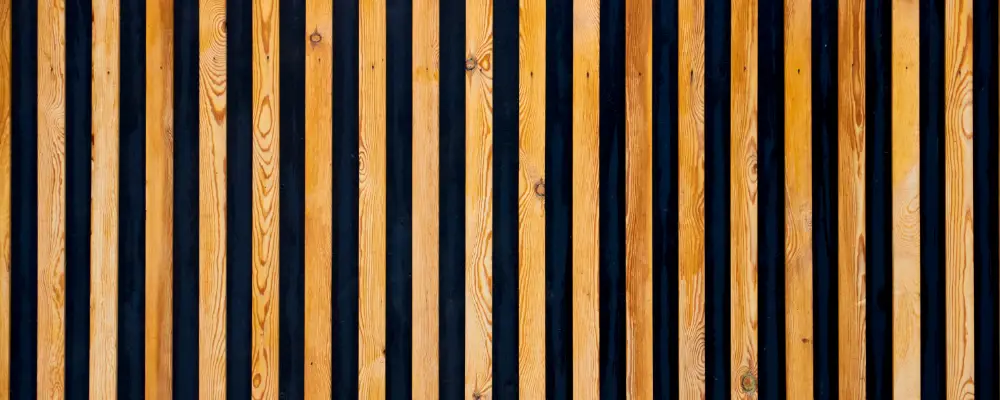Looking for ways to add warmth, texture, and dignity to your ambience? Giving it a wooden slatted accent might be the solution you never realised was right before you! Understated and very picturesque at the same time, wooden slats may be seen in every type of interior design, from a modern one to a very pronounced or even provocative facade. What’s pulling them into the spotlight? Let’s explore what goes on behind this trend.
What are Wooden Slats?
Wooden slats are narrow flat strips of wood, generally of standardised sizes, used at various levels of construction and design. Slats can be manufactured out of hardwoods like oak, walnut, or teak, or softwoods for reasons related to their purpose, cost issues, and client decision.
They are usually machined cuts that have been kiln-dried for dimensional stability so that the slats will not warp. Typical sizes vary from one application to another, but generally within the range:
- Width: 30 mm to 100 mm
- Thickness: 10 mm to 25 mm
- Length: 1 m to 3 m or more
Slats may be solid wood or engineered wood, i.e., laminated or composite sorts, that offer much more durability and moisture resistance.
Benefits of Using Wooden Slats in Construction

Aesthetic Versatility
Wooden slats provide a timeless and warm look to both modern and traditional architecture. They give great opportunities for creative expression, from vertical to horizontal placement, open to closed spacings, and range of stains or finishes to give life to the interior or exterior styles.
Thermal and Acoustic Insulation
Insulating properties are of natural wood. Wooden slats, if installed correctly with regard to spacing and suitable backing, will help mediate temperature variations and sound absorption. This is perfectly suitable for commercial and public spaces where acoustics work is important.
Sustainability
Wooden slats procured from sustainable sources can be considered an eco-friendly construction material. Wood has lower embodied energy than steel or concrete, and responsible forestry practices assure long-term availability and decreased carbon footprint.
Ease of Installation and Modification
Since it works on standardised profiles and mounting systems, wooden slats are best to install, replace, or modified with ease. Depending on the environment, slats may be treated against fire, UV degradation, and insect attack.
Durability
When properly treated and maintained, wooden slats can last decades. Hardwoods are especially resistant to decay, wear, and environmental abuse.
Common Applications of Wooden Slats in Construction
Wooden slats find widespread use in residential, commercial, and institutional projects. Some common applications include:
Wall Cladding (Interior & Exterior)
Slatted wall panels can act as decorative cladding to give rooms or vistas outside texture and warmth. Exterior-grade slats are normally treated for UV protection and waterproofing.
Ceilings and Acoustic Panels
From the standpoint of acoustic engineering, wooden slats are used in ceiling panels with the goal of lessening the echo and controlling reverb. Perforated backing or sound-absorbing insulation may often be installed behind the slats.
Room Dividers and Privacy Screens
The open slat design allows some level of visibility while laying out separate zones in open plan spaces. These are common in office interiors and residential layouts.
Fences and Facades
Vertical wooden slats as architectural facades may serve aesthetic and shading purposes. Exterior slatted fences provide a degree of privacy while allowing air and some light passage.
Furniture and Fixtures
Wooden slats are used for beds, benches, and shelving to give structural support and visual rhythm.
How to Install Wooden Slats: A Step-by-Step Guide
Material Selection
Choose wood according to the environment and purpose. Hardwoods like oak or teak are considered excellent materials for exterior use because of their durability, whereas softwoods such as pine should be utilized indoors. Alternatively, it tends to be a good idea to put down engineered or pre-treated slats wherever humidity or risk factors are concerned, since such treatments give these alternatives extra stability and resistance.
Measurement and Planning
Measure the surface and plan for slat spacing and orientation as well as their pattern. Consider expansion gaps, calculate the number of slats required, and finally mark layout lines with a level or laser to be sure that alignment is perfect once installed.
Surface Preparation
Make sure the wall or ceiling is clean, dry, and flat. Timber battens or plywood backing can be installed at 400-600 mm intervals for safe fixing. These allow for even spacing and ventilation where necessary, say, for external or acoustic requirements.
Mounting the Slats
Depending on preference, attach slats via screws, nails, clips, or track systems. Use spacers to ensure regular spacing and check alignment often. Stainless steel or anticorrosion fasteners should be used for durability.
Finishing
Apply the finish once the installation is complete. Consider oils or lacquers for indoor applications; UV- or moisture-resisting coatings for the outdoors. Follow manufacturer recommendations for drying and again reapply at intervals for protective life and good appearance.
Maintenance and Care for Wooden Slats
Cleaning
Dust the interior wood slats on a regular basis with a microfiber cloth or a vacuum with a soft-brush attachment. Exterior slats must be washed at least twice a year with mild soap and water to get rid of any dirt, mould, or mildew. Avoid the use of harsh chemicals that can corrode the finish of the wood.
Inspection
Perform routine inspections, rarely less than once a year, for stainings with warping, cracking, insect activities, and moisture damages so that early detection can prevent the issues from becoming structural and aesthetic.
Refinish
Depending on its exposure, perhaps every 2-5 years, wood finishes are reapplied. Sand very gently to remove dirt and colour stains, and then apply oil, sealant, or exterior-grade stain fairly evenly to protect colour from weathering.
Pest Protection
Borate treatments and insect-repellent coatings should be applied in any area liable to attacks from termites or wood-boring insects. Maintain the environment of the exterior slats within dry and well-ventilated zones, thus reducing the chances of fungal development and consequent decay.
Conclusion
If there is one product that lies at the junction of practicality, aesthetics, and sustainability in contemporary building construction, it has to be wooden slats. Being amenable to a wide variety of design idioms-driving architects toward a seemingly endless number of combinations of design, installation, and configuring materials for specific performance benefits. If specified, installed, and maintained properly, wooden slat systems can provide value for an indefinite period, thereby perpetually enriching the sensory and environmental quality of the created built environment.

